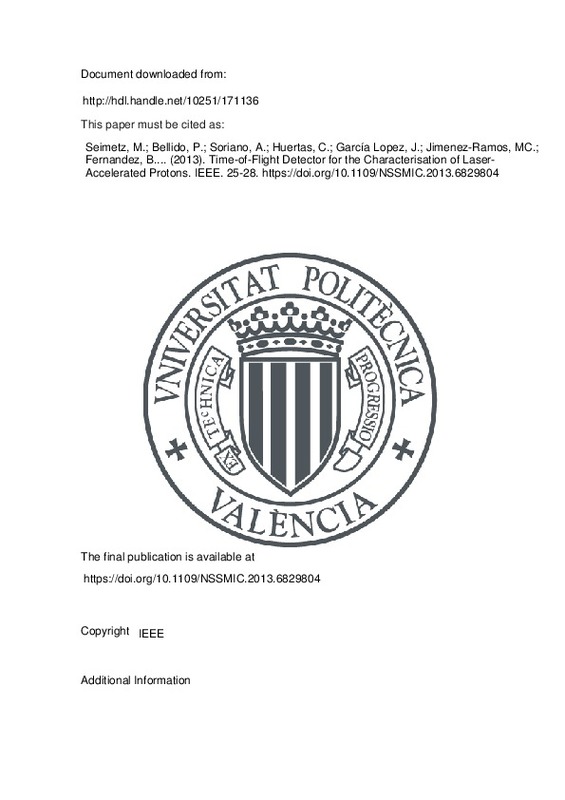Seimetz, M.; Bellido, P.; Soriano, A.; Huertas, C.; García Lopez, J.; Jimenez-Ramos, MC.; Fernandez, B.... (2013). Time-of-Flight Detector for the Characterisation of Laser-Accelerated Protons. IEEE. 25-28. https://doi.org/10.1109/NSSMIC.2013.6829804
Por favor, use este identificador para citar o enlazar este ítem: http://hdl.handle.net/10251/171136
|
Título:
|
Time-of-Flight Detector for the Characterisation of Laser-Accelerated Protons
|
|
Autor:
|
 Seimetz, Michael
Bellido, P.
Soriano, A.
Huertas, C.
García Lopez, J.
Jimenez-Ramos, M. C:
Fernandez, B.
Seimetz, Michael
Bellido, P.
Soriano, A.
Huertas, C.
García Lopez, J.
Jimenez-Ramos, M. C:
Fernandez, B.
 Conde, P.
Crespo, E.
Conde, P.
Crespo, E.
 González Martínez, Antonio Javier
Hernández, L.
Iborra, A.
Martos, F.
González Martínez, Antonio Javier
Hernández, L.
Iborra, A.
Martos, F.
 Moliner, L.
Rigla, J. P.
Moliner, L.
Rigla, J. P.

 Rodríguez-Álvarez, M.J.
Rodríguez-Álvarez, M.J.
 Sánchez, F.
Sánchez, F.
 Vidal San Sebastian, Luis Fernando
Vidal San Sebastian, Luis Fernando

 Benlloch Baviera, Jose María
Benlloch Baviera, Jose María
|
|
Entidad UPV:
|
Universitat Politècnica de València. Departamento de Matemática Aplicada - Departament de Matemàtica Aplicada
Universitat Politècnica de València. Instituto de Instrumentación para Imagen Molecular - Institut d'Instrumentació per a Imatge Molecular
|
|
Fecha difusión:
|
|
|
Resumen:
|
[EN] Lasers of ultra-high intensity focused on thin targets can form plasmas and release large numbers of charged particles with kinetic energies in the MeV region. The characterization of the accelerated particles requires ...[+]
[EN] Lasers of ultra-high intensity focused on thin targets can form plasmas and release large numbers of charged particles with kinetic energies in the MeV region. The characterization of the accelerated particles requires suitable detectors. We present a time-of-flight detector based on a plastic scintillator optimized for the spectral analysis of laser-accelerated protons. All details of the detector layout are adapted to the expected properties of the proton beam. Particle energies will be separated by the time-of-flight technique over 200 cm path length. The active area (25 mm width) corresponds to a few mrad opening angle. With 5 mm thickness the detector is capable of absorbing protons up to 22.5 MeV. A very thin, aluminized mylar foil shields the scintillator from outer light while absorbing very little particle energy. The scintillation photons are measured with a photomultiplier tube coupled through a bundle of optical fibres. The coupling of these fibres via a PMMA light guide has been previously optimized in simulations with Litrani. A critical aspect of the detection of virtually large numbers of protons emitted in femtosecond pulses is the saturation of the PMT. The latter can be avoided by use of appropriate optical filters. With these the effective dynamic range starts from single particles over several orders of magnitude. Our time-of-flight detector has been calibrated at the Spanish National Accelerator Centre at Sevilla. Proton beams from 0.46 to 5.6 MeV from a tandem accelerator have been used to measure the relation between particle energy and pulse heights. Further tests have been performed with a pulsed electron beam to simulate many-particle hits.
[-]
|
|
Palabras clave:
|
Laser ion acceleration
,
Time-of-flight measurement
,
Proton detector
|
|
Derechos de uso:
|
Reserva de todos los derechos
|
|
ISBN:
|
978-1-4799-0534-8
|
|
Fuente:
|
2013 IEEE Nuclear Science Symposium and Medical Imaging Conference (2013 NSS/MIC).
|
|
DOI:
|
10.1109/NSSMIC.2013.6829804
|
|
Editorial:
|
IEEE
|
|
Versión del editor:
|
https://doi.org/10.1109/NSSMIC.2013.6829804
|
|
Título del congreso:
|
IEEE Nuclear Science Symposium and Medical Imaging Conference, and Room-Temperature Semiconductor X-Ray and Gamma-Ray Detectors Workshop (2013 IEEE NSS/MIC/RTSD)
|
|
Lugar del congreso:
|
Seoul, Korea
|
|
Fecha congreso:
|
Octubre 27-Noviembre 02,2013
|
|
Código del Proyecto:
|
info:eu-repo/grantAgreement/MICINN//IPT-2011-0862-900000/ES/Diseño y desarrollo de elementos tecnológicos para la aceleración de partículas mediante láseres ultracortos y ultraintensos/
info:eu-repo/grantAgreement/GVA//ISIC%2F2011%2F013/
info:eu-repo/grantAgreement/MICINN//FIS2010-21216-C02-01/ES/DESARROLLO DEL DETECTOR PET%2FRM PARA DIAGNOSTICO DE ENFERMEDADES NEURODEGENERATIVAS./
info:eu-repo/grantAgreement/GVA//PROMETEOII%2F2013%2F010/
|
|
Agradecimientos:
|
Project funded by the Spanish Ministry of Economy and Competitiveness and co-funded with FEDER¿s funds within the INNPACTO 2011 program, Grant No. IPT-2011-0862- 900000. This work was supported by the Spanish Plan Nacional ...[+]
Project funded by the Spanish Ministry of Economy and Competitiveness and co-funded with FEDER¿s funds within the INNPACTO 2011 program, Grant No. IPT-2011-0862- 900000. This work was supported by the Spanish Plan Nacional de Investigacion Científica, Desarrollo e Innovacion Tecnológica (I+D+i) under Grant No. FIS2010-21216-CO2-01 and the Valencian Local Government under Grants PROMETEOII/2013/010 and ISIC 2011/013
[-]
|
|
Tipo:
|
Comunicación en congreso
Capítulo de libro
|







![[Cerrado]](/themes/UPV/images/candado.png)


